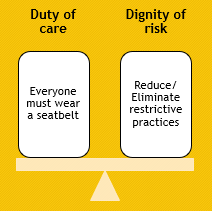The Stayput Safety Belt Security System is a complete seat belt assembly which is significantly different in application and price to a Seat Belt Buckle Cover/Guard. Although both solutions aim to prevent unbuckling of seat belts, only Stayput addresses the requirements of not impeding removal of a person in an emergency and reducing/eliminating the Use of Restrictive Practices in the Disability Service Sector. A comparison table of both approaches is available here
The Stayput Safety Belt Security System is a complete seat belt assembly, which when installed by a vehicle modification company, replaces the existing seat belt in your vehicle. Hence, this is not easily transferred between vehicles like a buckle cover/guard or harness.
No, you must not install the system yourself. Installation must be carried out by a Stayput certified installation company to ensure correct operation.
It is important to understand that Stayput seat belts are normal seat belts in the deactivated state (ie: when a driver has not been issued an authorisation key or has not activated the security option, or the vehicle is OFF, or in event of accident), and that the design intent is to allow a driver to restrict access to the release button only when everybody must by law wear a seat belt.
That said, there are two perspectives to consider when addressing the issue of seat belt unbuckling. These are road safety legislation mandating the use of seat belts in vehicles that are moving, or stationary but not parked

Our market research included seeking advice from transport authorities and restrictive practice governing bodies in order to satisfy the requirements of both sides of this balancing act. We found Transport authorities accepting of the Stayput system (some Jurisdictions require conditional registration), whilst restrictive practice governing bodies view it as a “least restrictive option” in comparison to currently available supports and one that is particularly easy to fade out.
Do we offer advice?
Assessing a person’s restraint and offering solutions requires an understanding of the factors contributing to unsafe behaviour in a vehicle. This could be related to sensory sensitivity to touch, or anxiety about the destination, travel route or even the vehicle environment. Stayput recommends seeking advice from an Occupational Therapist and Positive Behaviour Support Practitioner to maximise positive outcomes for a person requiring support to travel safely.
We do direct people to national guidelines such as AS/NZS 4370:2013 Restraint of children with disabilities, or medical conditions, in motor vehicles; NDIS Quality and Safeguarding Framework; and supporting resources in various jurisdictions. Eg: Department of Health and Human Services, State Government of Victoria, "Transportation of children with disabilities who display behaviours of concern - Clinical reasoning guide for occupational therapists".
A typical application of these guidelines and resources may, for example, result in an individual's Behaviour Support plan, as part of a broader strategy to manage behaviours of concern, specifying the Stayput security feature only be activated during times of increased anxiety known to lead to unbuckling behaviour and deactivated when calm is restored. Furthermore, a plan may endeavour to reduce the frequency of use of the security feature over time through travel training aimed at developing an occupant’s skills in the independent and safe use of seat belts.
ACT - http://www.actosp.org.au/
SA - http://www.dcsi.sa.gov.au/services/disability-sa/office-of-the-senior-practitioner ; http://www.opa.sa.gov.au/resources/restrictive_practices
TAS - http://www.dhhs.tas.gov.au/disability/senior_practitioner